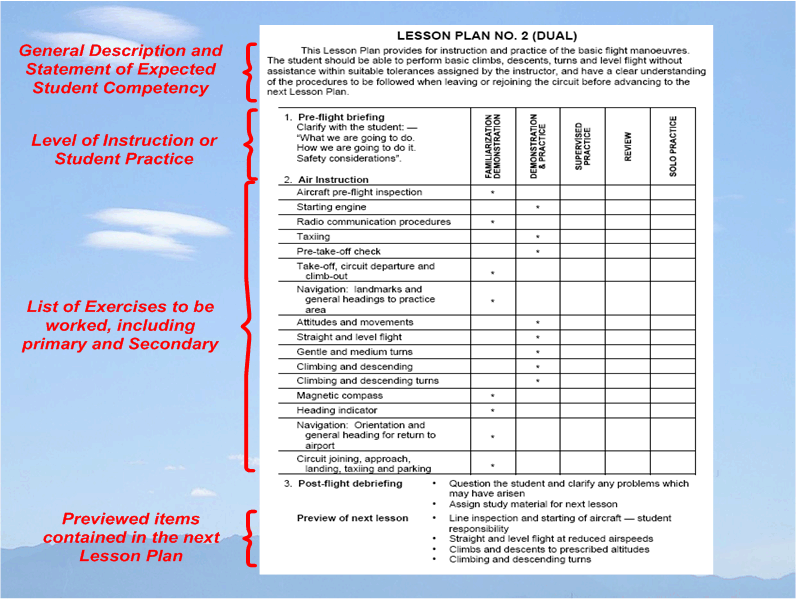Transport Canada's Lesson Plan Format
The Lesson Plan section of the flight instructor guide forms a well thought out set of documents that provide. Here is a copy of Lesson Plan 2:

General Descriptive Paragraph
At the top of the page is a general description of the lesson plan. It appears in paragraph form and typically describes the overall cool of the lesson plan, as well as the general level of competency that should be achieved by the typical student. Besides the Flight Test Guides, which is really the final product of training, the general description section is the only location in all flight training information published by Transport Canada where performance standards or expectations during ab initio training are specified. It is good advice to go through the general descriptive statements for each lesson plan and highlight the statements of standards and expectations. There is always advised to the instructor as to when the student reaches a sufficient level of competency to advance to the subsequent lesson plan. Get familiar with these if you can.
Level of Instruction or Student Practice
The next section, below the descriptive paragraph, is core of the lesson plan. It has headings along the top—familiarization-demonstration, demonstration and practice, supervised practice, review, and solo practice. These headings specify the level of activity for the air instruction items, and you can see that, as you progress from left to right, the student attains more and more independence with regard to performing the exercise or task. The progression begins on the left with familiarization-demonstration, when an exercise is demonstrated by the flight instructor for the first time, leading to the far until during solo practice, where the student is simply improving learned skills through practice, without active supervision by the flight instructor. In between these are progressive teaching/practice levels of activity. Demonstration and practice specifies that the exercise or item is actively taught by the instructor for the first time. Typically, the exercise or item would have been demonstrated on the previous flight, and actively discussed by the instructor and student just prior to the current flight, either during Preparatory Ground Instruction or the Pre-flight Briefing. Typically, major exercises are the subject of dedicated Preparatory Ground Instruction, while lessor exercises or items are reviewed with the student in the Pre-flight Briefing.
Pre-flight Briefing
Section 1 is the Pre-flight Briefing section, and the statement that appears here is standard, serving like a checklist pertaining to what should be discussed during the pre-flight briefing. In fact there should be more items listed in a proper Pre-Flight Briefing checklist.
Air Instruction
Section 2, named Air Instruction proper, is the chronological listing of the events that will occur during the training flight. This is truly the central core of the lesson plan. The example here is Lesson Plan 2, so there are lots of detailed subjects addressed pertaining to students just starting in their training, but Lesson Plan 2 is typical in the general flow of the Air Instruction section. You will note that this section contains, generally, a standard sequence that make up the training flight: pretakeoff, takeoff, departure and navigation to the practice area, the core air exercises taught and practiced in the practice area, the navigation and arrival back at the airport, the approach and landing, and shutdown. These items will be reviewed for each lesson plan in greater detail.
Post-flight Debriefing
Section 3 contains the checklist for the Post-flight Debriefing, and of course this is standard with each lesson plan.
The final section prompts the instructor to review the reading assignments, etc., for the next flight.
.jpg)

